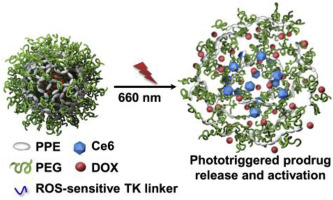当前位置:
X-MOL 学术
›
Biomaterials
›
论文详情
Our official English website, www.x-mol.net, welcomes your
feedback! (Note: you will need to create a separate account there.)
ROS-sensitive thioketal-linked polyphosphoester-doxorubicin conjugate for precise phototriggered locoregional chemotherapy.
Biomaterials ( IF 12.8 ) Pub Date : 2018-10-11 , DOI: 10.1016/j.biomaterials.2018.10.010 Pei Pei 1 , Chunyang Sun 2 , Wei Tao 1 , Jie Li 1 , Xianzhu Yang 3 , Jun Wang 4
Biomaterials ( IF 12.8 ) Pub Date : 2018-10-11 , DOI: 10.1016/j.biomaterials.2018.10.010 Pei Pei 1 , Chunyang Sun 2 , Wei Tao 1 , Jie Li 1 , Xianzhu Yang 3 , Jun Wang 4
Affiliation

|
Minimizing drug leakage at off-target sites and triggering sufficient drug release in tumor tissue are major objectives for effective nanoparticle (NP)-based cancer therapy. The current covalent and cleavable drug-NP conjugation strategy is promising but lacks high controllability to realize tumor-specific release. As a proof-of-concept, the reactive oxygen species (ROS)-activatable thioketal (TK) bond was explored as the linkage between doxorubicin (DOX) and polyphosphoester (PPE-TK-DOX). The Ce6@PPE-TK-DOX NPs constructed by co-self-coassembly of PPE-TK-DOX and the photosensitizer Ce6 efficiently prevented premature drug leakage in the off-target tissue and cells because of the high stability of the TK bond under physiological conditions. Once circulating into the tumor site, the 660-nm red light was precisely employed to irradiate the tumor area under the guidance of fluorescence/magnetic resonance (MR) dual-model imaging, which can induce localized ROS generation, resulting in rapid cleavage of the TK bond. Consequently, the DOX prodrug was locoregionally released and activated, achieving tumor-specific drug delivery with high controllability by light. Such phototriggered prodrug release and activation at the desired site significantly enhanced the therapeutic efficacy and minimized the side effect, providing new avenues to develop drug delivery systems for remote on-demand drug delivery in vivo.
中文翻译:

ROS敏感的硫代缩酮连接的多磷酸酯-阿霉素结合物,用于精确的光触发局部化疗。
使脱靶部位的药物泄漏最小化并触发肿瘤组织中充分的药物释放是有效的基于纳米颗粒(NP)的癌症治疗的主要目标。当前的共价和可裂解的药物-NP缀合策略是有前途的,但缺乏实现肿瘤特异性释放的高度可控性。作为概念验证,研究了活性氧(ROS)活化的硫缩酮(TK)键作为阿霉素(DOX)和聚磷酸酯(PPE-TK-DOX)之间的联系。由PPE-TK-DOX和光敏剂Ce6共同自组装构建的Ce6 @ PPE-TK-DOX NPs有效地防止了脱靶组织和细胞中过早的药物泄漏,因为TK键在生理条件下具有很高的稳定性条件。一旦循环到肿瘤部位,在荧光/磁共振(MR)双模式成像的引导下,精确地使用660 nm红光照射肿瘤区域,这可以诱导局部ROS的产生,从而导致TK键的快速裂解。因此,DOX前药在局部区域被释放并被激活,从而实现了光特异性可控性的肿瘤特异性药物递送。此类光触发的前药在所需位点的释放和活化显着增强了治疗功效,并将副作用降至最低,为开发用于体内远程按需药物输送的药物输送系统提供了新途径。DOX前药在局部区域被释放并被激活,通过光可高度控制地实现肿瘤特异性药物的递送。此类光触发的前药在所需位点的释放和活化显着增强了治疗功效,并将副作用降至最低,为开发用于体内远程按需药物输送的药物输送系统提供了新途径。DOX前药在局部区域被释放并被激活,通过光可高度控制地实现肿瘤特异性药物的递送。此类光触发的前药在所需位点的释放和活化显着增强了治疗功效,并将副作用降至最低,为开发用于体内远程按需药物输送的药物输送系统提供了新途径。
更新日期:2018-10-11
中文翻译:

ROS敏感的硫代缩酮连接的多磷酸酯-阿霉素结合物,用于精确的光触发局部化疗。
使脱靶部位的药物泄漏最小化并触发肿瘤组织中充分的药物释放是有效的基于纳米颗粒(NP)的癌症治疗的主要目标。当前的共价和可裂解的药物-NP缀合策略是有前途的,但缺乏实现肿瘤特异性释放的高度可控性。作为概念验证,研究了活性氧(ROS)活化的硫缩酮(TK)键作为阿霉素(DOX)和聚磷酸酯(PPE-TK-DOX)之间的联系。由PPE-TK-DOX和光敏剂Ce6共同自组装构建的Ce6 @ PPE-TK-DOX NPs有效地防止了脱靶组织和细胞中过早的药物泄漏,因为TK键在生理条件下具有很高的稳定性条件。一旦循环到肿瘤部位,在荧光/磁共振(MR)双模式成像的引导下,精确地使用660 nm红光照射肿瘤区域,这可以诱导局部ROS的产生,从而导致TK键的快速裂解。因此,DOX前药在局部区域被释放并被激活,从而实现了光特异性可控性的肿瘤特异性药物递送。此类光触发的前药在所需位点的释放和活化显着增强了治疗功效,并将副作用降至最低,为开发用于体内远程按需药物输送的药物输送系统提供了新途径。DOX前药在局部区域被释放并被激活,通过光可高度控制地实现肿瘤特异性药物的递送。此类光触发的前药在所需位点的释放和活化显着增强了治疗功效,并将副作用降至最低,为开发用于体内远程按需药物输送的药物输送系统提供了新途径。DOX前药在局部区域被释放并被激活,通过光可高度控制地实现肿瘤特异性药物的递送。此类光触发的前药在所需位点的释放和活化显着增强了治疗功效,并将副作用降至最低,为开发用于体内远程按需药物输送的药物输送系统提供了新途径。











































 京公网安备 11010802027423号
京公网安备 11010802027423号